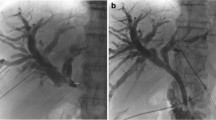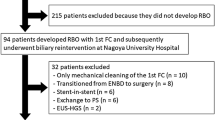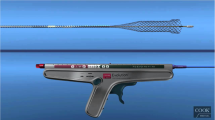Abstract
The purpose of this study was to compare the clinical effectiveness of expanded polytetrafluoroethylene/fluorinated-ethylene-propylene (ePTFE/FEP)–covered stents with that of uncovered nitinol stents for the palliation of malignant jaundice caused by inoperable pancreatic head cancer. Eighty patients were enrolled in a prospective randomized study. Bare nitinol stents were used in half of the patients, and ePTFE/FEP–covered stents were used in the remaining patients. Patency, survival, complications, and mean cost were calculated in both groups. Mean patency was 166.0 ± 13.11 days for the bare-stent group and 234.0 ± 20.87 days for the covered-stent group (p = 0.007). Primary patency rates at 3, 6, and 12 months were 77.5, 69.8, and 69.8% for the bare-stent group and 97.5, 92.2, and 87.6% for the covered-stent group, respectively. Mean secondary patency was 123.7 ± 22.5 days for the bare-stent group and 130.3 ± 21.4 days for the covered-stent group. Tumour ingrowth occurred exclusively in the bare-stent group in 27.5% of cases (p = 0.002). Median survival was 203.2 ± 11.8 days for the bare-stent group and 247.0 ± 20 days for the covered-stent group (p = 0.06). Complications and mean cost were similar in both groups. Regarding primary patency and ingrowth rate, ePTFE/FEP–covered stents have shown to be significantly superior to bare nitinol stents for the palliation of malignant jaundice caused by inoperable pancreatic head cancer and pose comparable cost and complications. Use of a covered stent does not significantly influence overall survival rate; nevertheless, the covered endoprosthesis seems to offer result in fewer reinterventions and better quality of patient life.




Similar content being viewed by others
References
Parkin DM, Bray F, Ferlay J et al (2005) Global cancer statistics, 2002. CA Cancer J Clin 55:74–108
Lowenfels AB, Maisonneuve P (2006) Epidemiology and risk factors for pancreatic cancer. Best Pract Res Clin Gastroenterol 20:197–209
Bramhall SR, Allum WH, Jones AG et al (1995) Treatment and survival in 13,560 patients with pancreatic cancer, and incidence of the disease, in the West Midlands: an epidemiological study. Br J Surg 82:111–115
Connolly MM, Dawson PJ, Michelassi F et al (1987) Survival in 1001 patients with carcinoma of the pancreas. Ann Surg 206:366–373
Michelassi F, Erroi F, Dawson PJ et al (1989) Experience with 647 consecutive tumors of the duodenum, ampulla, head of the pancreas, and distal common bile duct. Ann Surg 210:544–554
Shepherd HA, Royle G, Ross AP et al (1988) Endoscopic biliary endoprosthesis in the palliation of malignant obstruction of the distal common bile duct: a randomized trial. Br J Surg 75:1166–1168
Smith AC, Dowsett JF, Russell RC et al (1994) Randomised trial of endoscopic stenting versus surgical bypass in malignant low bile duct obstruction. Lancet 344(8938):1655–1660
Bornman PC, Harries-Jones EP, Tobias R et al (1986) Prospective controlled trial of transhepatic biliary endoprosthesis versus bypass surgery for incurable carcinoma of head of pancreas. Lancet 1(8472):69–71
Andersen JR, Sorensen SM, Kruse A et al (1989) Randomised trial of endoscopic endoprosthesis versus operative bypass in malignant obstructive jaundice. Gut 30:1132–1135
Artifon EL, Sakai P, Cunha JE et al (2006) Surgery or endoscopy for palliation of biliary obstruction due to metastatic pancreatic cancer. Am J Gastroenterol 101:2031–2037
Lammer J, Hausegger KA, Fluckiger F et al (1996) Common bile duct obstruction due to malignancy: treatment with plastic versus metal stents. Radiology 201:167–172
Rossi P, Bezzi M, Salvatori FM et al (1997) Clinical experience with covered Wallstents for biliary malignancies: 23-month follow-up. Cardiovasc Intervent Radiol 20:441–447
Hausegger KA, Thurnher S, Bodendorfer G et al (1998) Treatment of malignant biliary obstruction with polyurethane covered Wallstents. AJR Am J Roentgenol 170:403–408
Miyayama S, Matsui O, Terayama T et al (1997) Covered Gianturco stents for malignant biliary obstruction: Preliminary clinical evaluation. J Vasc Interv Radiol 8:641–648
Han YM, Jin GY, Lee S et al (2003) Flared polyurethane-covered self-expandable nitinol stent for malignant biliary obstruction. J Vasc Interv Radiol 14:1291–1301
Kanasaki S, Furukawa A, Kane T et al (2000) Polyurethane-covered nitinol Strecker stents as primary palliative treatment of malignant biliary obstruction. Cardiovasc Intervent Radiol 23:114–120
Isayama H, Komatsu Y, Tsujino T et al (2002) Polyurethane-covered metal stent for management of distal malignant biliary obstruction. Gastrointest Endosc 55:366–370
Isayama H, Komatsu Y, Tsujino T et al (2004) A prospective randomized study of “covered” versus “uncovered” diamond stents for the management of distal malignant biliary obstruction. Gut 53:729–734
Schoder M, Rossi P, Uflacker R et al (2002) Malignant biliary obstruction: treatment with ePTFE/FEP-covered endoprostheses―initial technical and clinical experiences in a multicenter trial. Radiology 225:35–42
Bezzi M, Zolovkins A, Cantisani V et al (2002) New ePTFE/FEP-covered stent in the palliative treatment of malignant biliary obstruction. J Vasc Interv Radiol 13:581–589
Hatzidakis A, Krokidis M, Kalbakis K et al (2007) ePTFE/FEP-covered metallic stents for palliation of malignant biliary disease: Can tumor ingrowth be prevented? Cardiovasc Intervent Radiol 30:950–958
Fanelli F, Orgera G, Bezzi M et al (2008) Management of malignant biliary obstruction: technical and clinical results using an expanded polytetrafluoroethylene fluorinated ethylene propylene (ePTFE/FEP)-covered metallic stent after 6-year experience. Eur Radiol 18:911–919
Krokidis M, Fanelli F, Orgera G et al (2010) Percutaneous treatment of malignant jaundice due to extrahepatic cholangiocarcinoma: covered Viabil stent versus uncovered Wallstents. Cardiovasc Intervent Radiol 33:97–106
Engelken FJ, Bettschart V, Rahman MQ et al (2003) Prognostic factors in the palliation of pancreatic cancer. Eur J Surg Oncol 29:368–373
Ueno H, Okada S, Okusaka T et al (2000) Prognostic factors in patients with metastatic pancreatic adenocarcinoma receiving systemic chemotherapy. Oncology 59:296–301
Falconer JS, Fearon KC, Ross JA et al (1995) Acute-phase protein response and survival duration of patients with pancreatic cancer. Cancer 75:2077–2082
Barber MD, Ross JA, Fearon KC (1999) Changes in nutritional, functional, and inflammatory markers in advanced pancreatic cancer. Nutr Cancer 35:106–110
WHO handbook for reporting results of cancer treatment (1979) World Health Organization, Geneva, Switzerland
Sacks D, McClenny TE, Cardella JF et al (2003) Society of Interventional Radiology clinical practice guidelines. J Vasc Interv Radiol 14:199–202
Kaplan EL, Meier P (1958) Nonparametric estimation from incomplete observations. J Am Stat Assoc 53:457–481
Gold EB (1995) Epidemiology of and risk factors for pancreatic cancer. Surg Clin North Am 75:819–843
Sohn TA, Lillemoe KD, Cameron JL et al (1999) Surgical palliation of unresectable periampullary adenocarcinoma in the 1990s. J Am Coll Surg 188:658–669
Baron TH (2001) Expandable metal stents for the treatment of cancerous obstruction of the gastrointestinal tract. N Engl J Med 344:1681–1687
Kim HO, Hwang SI, Kim H et al (2008) Quality of survival in patients treated for malignant biliary obstruction caused by unresectable pancreatic head cancer: surgical versus non-surgical palliation. Hepatobiliary Pancreat Dis Int 7:643–648
Scott EN, Garcea G, Doucas H et al (2009) Surgical bypass vs. endoscopic stenting for pancreatic ductal adenocarcinoma. HPB (Oxford) 11:118–124
Nakamura T, Hirai R, Kitagawa M et al (2002) Treatment of common bile duct obstruction by pancreatic cancer using various stents: single-centre experience. Cardiovasc Interv Radiol 25:373–380
Isayama H, Kawabe T, Nakai Y et al (2010) Management of distal malignant biliary obstruction with the ComVi stent, a new covered metallic stent. Surg Endosc 24:131–137
Ho H, Mahajan A, Gosain S et al (2010) Management of complications associated with partially covered biliary metal stents. Dig Dis Sci 55:516–522
Rossi P, Bezzi M, Rossi M et al (1994) Metallic stents in malignant biliary obstruction: results of a multicenter European study of 240 patients. J Vasc Interv Radiol 5:279–285
Lee BH, Choe DH, Lee JH et al (1997) Metallic stents in malignant biliary obstruction: prospective long-term clinical results. AJR Am J Roentgenol 168:741–745
Brountzos EN, Ptochis N, Panagiotou I et al (2007) A survival analysis of patients with malignant biliary strictures treated by percutaneous metallic stenting. Cardiovasc Intervent Radiol 30:66–73
Katsinelos P, Kountouras J, Paroutoglou G et al (2008) Uncovered Hanaro versus Luminex metal stents for palliation of malignant biliary strictures. J Clin Gastroenterol 42:539–545
Boguth L, Tatalovic S, Antonucci F et al (1994) Malignant biliary obstruction: clinical and histopathologic correlation after treatment with self-expanding metal prostheses. Radiology 192:669–674
Author information
Authors and Affiliations
Corresponding author
Rights and permissions
About this article
Cite this article
Krokidis, M., Fanelli, F., Orgera, G. et al. Percutaneous Palliation of Pancreatic Head Cancer: Randomized Comparison of ePTFE/FEP–Covered Versus Uncovered Nitinol Biliary Stents. Cardiovasc Intervent Radiol 34, 352–361 (2011). https://doi.org/10.1007/s00270-010-9880-4
Received:
Accepted:
Published:
Issue Date:
DOI: https://doi.org/10.1007/s00270-010-9880-4




